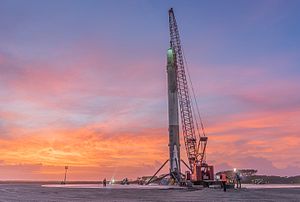
Back نظام إطلاق قابل لإعادة الاستخدام Arabic পুনঃব্যবহারযোগ্য উৎক্ষেপণ ব্যবস্থা Bengali/Bangla Sistema de llançament reutilitzable Catalan پێڕاگوێزی ھەڵدانی دووبارە بەکارھاتوو CKB Raumfähre German Επαναχρησιμοποιήσιμο σύστημα εκτόξευσης Greek Reuzebla lanĉo-sistemo Esperanto Sistema de lanzamiento reutilizable Spanish Korduvkasutatav kanderaketisüsteem Estonian سامانه پرتاب بازکاربردپذیر Persian

| Part of a series on |
| Spaceflight |
|---|
 |
|
|
A reusable launch vehicle has parts that can be recovered and reflown, while carrying payloads from the surface to outer space. Rocket stages are the most common launch vehicle parts aimed for reuse. Smaller parts such as rocket engines and boosters can also be reused, though reusable spacecraft may be launched on top of an expendable launch vehicle. Reusable launch vehicles do not need to make these parts for each launch, therefore reducing its launch cost significantly. However, these benefits are diminished by the cost of recovery and refurbishment.
Reusable launch vehicles may contain additional avionics and propellant, making them heavier than their expendable counterparts. Reused parts may need to enter the atmosphere and navigate through it, so they are often equipped with heat shields, grid fins, and other flight control surfaces. By modifying their shape, spaceplanes can leverage aviation mechanics to aid in its recovery, such as gliding or lift. In the atmosphere, parachutes or retrorockets may also be needed to slow it down further. Reusable parts may also need specialized recovery facilities such as runways or autonomous spaceport drone ships. Some concepts rely on ground infrastructures such as mass drivers to accelerate the launch vehicle beforehand.
Since at least in the early 20th century, single-stage-to-orbit reusable launch vehicles have existed in science fiction. In the 1960s and 1970s, the first reusable launch vehicles were manufactured, named the Space Shuttle and Energia. However, in the 1990s, due to both programs' failure to meet expectations, reusable launch vehicle concepts were reduced to prototype testing. The rise of private spaceflight companies in the 2000s and 2010s lead to a resurgence of their development, such as in SpaceShipOne, New Shepard, Electron, Falcon 9, and Falcon Heavy. Many launch vehicles are now expected to debut with reusability in the 2020s, such as Starship, New Glenn, Neutron, Soyuz-7, Ariane Next, Long March, Terran R, and the Dawn Mk-II Aurora.[1]
- ^ "Dawn Aerospace unveils the Mk II Aurora suborbital space plane, capable of multiple same-day flights". TechCrunch. 28 July 2020. Retrieved 2022-08-19.
© MMXXIII Rich X Search. We shall prevail. All rights reserved. Rich X Search